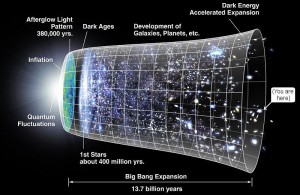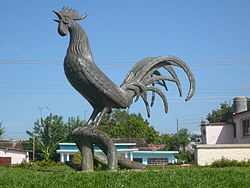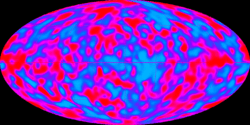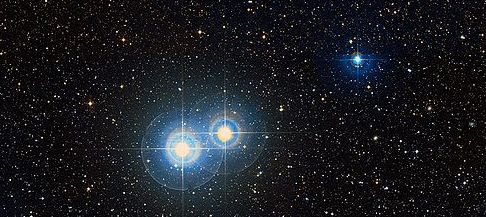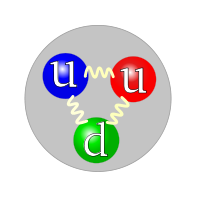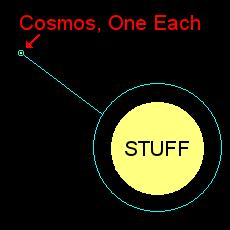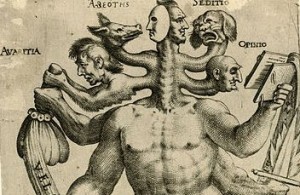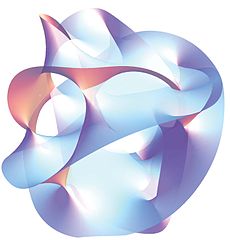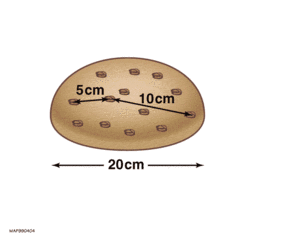Timeline of the universe, courtesy of NASA. (I added
the “you are here” thingie.) Click for a larger image.
![]()
The biggest problem with the Big Bang theory of the origin of the universe is philosophical — perhaps even theological — what was there before the Bang? — John Gribbin, speaking in Nature magazine
![]()
From Steady State To Big Bang
In the online Origins discussion groups back in the 90’s, it was All Evolution, All The Time [insert jangly radio jingle here]. The same arguments would be repeated, round and round and over and over. (Kind of like a well-orchestrated dance, but with boxing gloves.)
“Radioactive dating is inaccurate.”
“It’s radiometric dating and no, it’s not.”
“Whatever. Is too!”
“Is not!”
Then a Creationist would ask where life came from in the first place. He would be solemnly reminded that Abiogenesis (“life from non life”) wasn’t part of the Theory of Evolution.
“OK, whatever, but where did life come from in the first place so that evolution could do its job?”
Some of the arguments made as much sense
as the giant metal rooster in Moron, Cuba.
![]()
Plenty Of Time == No Problem
At the time, the Steady State Theory (which I mentioned earlier) was often cited. The universe was believed to be unfathomably ancient and huge. “Plenty of time,” would come the inevitable response. An Appeal To Many Chances, free of charge. They’d return to arguing about radiometric dating and whether the fossil record was bogus.
Science fiction writers seemed to prefer the Oscillating Universe (sometimes called the “Bouncing” or “Cyclic Universe”) — the idea that the Cosmos would expand, then contract and expand again, over and over — probably because it made for a better plot (see Fred Pohl’s Heechee series for a classic example). Another Appeal To Many Chances: who was to say that our current universe wasn’t just a “lucky bounce” that was specially suited to life?
Both theories have now fallen out of favor.
The Steady State was abandoned because the “state” of the cosmos isn’t “steady.” Better telescopes allow astronomers to look back in time; they can see that things were quite different back then. The Oscillating Universe had some technical problems, but that’s a moot point now. The expansion of the Cosmos is actually accelerating. It’s not expected to collapse and there’s absolutely no way to know if “previous” universes were able to do so.
COBE’s now-famous “sky map”
![]()
The Cosmic Microwave Background
In 1992, the first Cosmic Background Explorer (COBE) satellite confirmed one of the key predictions of the Big Bang theory: “echoes” would appear throughout the Cosmos as microwaves. Penzias and Wilson had caught evidence of this back in the 1960’s with a big ol’ horn antenna, but many Cosmologists still weren’t satisfied. (Bunch of curmudgeons.)
COBE, on the other hand, convinced most of the holdouts. I watched ABC’s Nightline the evening that the results were announced. Koppel’s famous hairdo (The Do) was flawlessly helmet-like; he had obviously spent extra time in Makeup for the occasion. The program began with a quote from the Biblical book of Genesis.
In the days to come, theological pronouncements were common. One astronomer, Geoffrey Burbidge, complained that many of his fellows were running off to join the “Church Of The Big Bang.”
The skeptics with whom I first discussed this online were so focused on the Theory of Evolution (and pummeling Young Earth Creationists) that they were unaware of the then-new “Big Bang cosmology.” Even as late as 1999, I often had to explain it.
Now, of course, if you do a Web search, you’ll get as many hits from skeptic Websites as from creationist. They apparently see Big Bang cosmology and the implication of a Creator as a threat that must be addressed. But that certainly wasn’t the case for many years.
Penzias and Wilson admiring their
big ol’ honking horn antenna.
![]()
Before We Get Started
I’m not a physicist. This is a laycritter’s best attempt to explain things that, to be honest, are sometimes (way) over my head. Not all of the fine details have been settled yet, too. I’ve kept this discussion anchored at the “broad overview/basic principle” level and have embedded links to more in-depth information, if you’re interested.
I’ll start with a few points to be pondered:
- The Big Bang Theory (the science, not the sitcom) is as widely accepted in Cosmology as the Theory of Evolution is in Biology. There are alternate theories, but none enjoy the same consensus.
- The universe is between 13 and 14 billion years old*. The first several billion years were spent cooling, then forming stars and making the elements for planets and life chemistry. This drastically shortens the time available for life to arise.
- Time, as we know and measure it, has no meaning outside of our Cosmos. This has critical implications for the nature of any Creator that we might propose.
- Similarly, our Cosmos is not a Giant Thing sitting in “space;” what we know of as “space” is within our Cosmos.
Mr. and Mrs. Alpha Capricorni. Junior is off to the right.
![]()
Some Background
What you and I think of as “light” is the same as radio waves; they’re just at different frequencies. The particles (or more accurately, “quanta”) that carry (or “mediate”) these forces are called photons. In a similar way, physicists think that gravity is carried by gravitons.
I call them “particles,” but in fact, sometimes they act like waves. This is called the Wave-Particle Duality. You can think of them as little packets of energy that act weird.
There are a bunch of different particles responsible for what we see, hear, feel, eat and breathe. Each has a specific mass, ranging from zero to very “heavy” (in sub-atomic terms). Each has special characteristics: some have an electrical charge, some “mediate” a specific force. But by assembling these in different ways, we get our Cosmos.
In the middle of an atom, protons and neutrons are held together by little fellows called, appropriately enough, gluons (the little squiggly lines in the picture below). Peer inside the protons and neutrons and you’ll find even tinier particles called quarks (not to be confused with the ugly Ferengi who ran the bar on Star Trek: Deep Space Nine).
Here’s the thing: these little particles seem to change in all sorts of weird ways when you excite them. At higher energies, they can even become something entirely different. At the highest possible energy — this is critical — scientists wonder if they wouldn’t all be the same. They’d all lose their identities.
A Proton is two ups and one down quark. The colors
don’t matter as long as they’re different. (And
they can’t wear the same outfits to the party.)
![]()
We Start With STUFF
The universe began as a small point. Everything was squeezed together and it was unthinkably hot. Physicists believe that at that temperature, all of the particles had no identities and were part of One Big Energy Soup called the Superforce.
“Everything” means … everything. It all came from that tiny little point. (Except for God. He was outside of it. More on this later.)
There were no gravitons, no photons, no electrons, no bosons or pions or mesons or any other -ons. Just Superforce.
Because we are not physicists, we shall call this big, super-squished, hot soupy dot of energy, “STUFF.” (Reverently capitalized.)
The Universe just prior to birth,
magnified about a zillion times.
![]()
STUFF Becomes Other … Stuff
This is where most people say, “and then it exploded.” But that’s not accurate. (The explosions would come a moment later … and they were epic.) The baby Cosmos simply began expanding. For an instant, it grew in size by at least a trillion trillion trillion trillion trillion trillion times in less than a trillionth of a trillionth of a trillionth of a trillionth of second — give or take a smidge, but that’s not a typo.
In a bit of a dry understatement, physicists call this Inflation. STUFF yelled, “slow down, you’re gonna get us killed!” The Cosmos did so, expanding and cooling more slowly.
As it cooled, the elemental forces began to take on their identities. They assumed their identities one force/particle at a time, at different specific temperatures. Gravity (“gravitons”) appeared first. Next came the Strong Nuclear Force (“gluons”).
The particles that mediate the Weak Force (which gives us radioactivity, among other things) and electromagnetism appeared. The Higgs Boson also popped up about this time and gave mass to the particles.
(The poor dears gained weight and didn’t even get cake and ice cream.)

Happy Birthday, Cosmos!
![]()
The Large Hadron Collider (LHC)
How do scientists know this? They obviously can’t recreate the conditions at the very beginning.
If they tried, the authorities would probably send in a SWAT team. (Bunch of nanny-state wimps.) Even a sub-microscopic speck of STUFF could wipe out every galaxy in the Local Group if they lost containment. That would violate the Protected Species Act and every single member of PETA, worldwide, would git nekkid.
This is too horrible to contemplate (especially the PETA thing), so scientists have to be creative: they accelerate tiny particles to almost the speed of light, scream, “hey, ya’ll, watch this!” and smash them together. Where these particles collide, for just a brief instant, they get energies close to those of the early universe. Plenty of questions still remain, but they’ve learned a great deal, especially in the past few decades.
The Large Hadron Collider is the biggest accelerator ever built. It’s a loop 27 kilometers in circumference that straddles the border between France and Switzerland. The most celebrated discovery from the LHC as of this writing is that international celebrity, the Higgs Boson. Scientists say that they can see evidence of him in the spaghetti pictured below.
Restaurant Patron: “hey, thar’s a Higgs in mah sketti!”
Waitress: “that’s ahh-ite, we won’t charge extry fer it.”
Wait staff: high fives all around. Patron eats, gains mass.
![]()
Implications, Round One …
This one is obvious: our Cosmos had a beginning. This implies a “Begin-ner” — a Creator. What caused the Big Bang? How did that little dot stuffed with STUFF get there in the first place, then start expanding? What told those particles to assume the identities that they did as they cooled and “remembered themselves?”
Some have suggested that maybe there’s no actual “beginning” at the beginning, that it’s like going to the North Pole. Once you get there, you can’t go any “north-er.” That might work from the perspective of an observer inside this Cosmos, but it doesn’t solve the problem. Whether an artist draws a line with definite endpoints, or a “closed” circle with no endpoints, there’s still an Artist. (It’s surprising how many people, including some very bright ones, miss this.)
Then there is Quantum Theory, which (correctly) predicts that little virtual particles can appear, hang for a moment, then disappear. Some have suggested that perhaps the entire Cosmos popped up out of nothing. (That’s not a joke. They’re serious.)
Even if they’re right, you’re still stuck with the classic Prime Mover/First Cause problem: who or what created the conditions and/or set up the rules for a mechanism that could spit out an entire Cosmos? How did the STUFF “know” to create the correct particles, and in just the right amounts (more on this in the next section), so that we could be here?
Better question: WHAT WILL IT SPIT OUT NEXT?
![]()
Either Way: Awesome.
Some of the String/M-Theory folks believe that a great, transcendent principle or physical law will be discovered that explains all of this. The part of me that enjoys and loves science actually hopes they do figure this out someday.
But when they do, it won’t change what I believe. In fact, I will shout like a Pentecostal on Homecoming Sunday. (They have been warned.) See, either way, they’re simply proving that God is awesome. Either He guided this Cosmos to its current arrangement, or He set up everything in advance so that it would work out perfectly on its own. Net result: awesome.
So … think about it.
Popper said that the simplest explanation that fits the facts should apply. This isn’t “scientific,” but it’s gut-check time. Apply some common sense. Isn’t the simplest explanation that our universe had a beginning … and that something (or Someone) must have caused it?
A String Theorist’s coffee mug.
![]()
What (Or Who) Caused It?
To quote Gribbin again: “what was there before the Bang?” Here’s a hint. The Bible makes it clear that God exists outside of time. He was “causing and effecting” before this Cosmos existed (however you wish to define “before” in this case).
If you object, “how could God engage in cause and effect where there is no time?” I’ll reply, “demonstrate that cause and effect from within our Cosmos is the same as cause and effect from outside of our Cosmos.” (Another thing that many otherwise-bright people apparently miss. In plain English: who says the Rules “out there” are the same as the Rules “in here?”)
Here are a few quotes from the New International Version (emphasis mine in italics) …
- 1 Corinthians 2:7 – …we declare God’s wisdom, a mystery that has been hidden and that God destined for our glory before time began.
- 2 Timothy 1:9 – This grace was given us in Christ Jesus before the beginning of time
- Titus 1:2 – in the hope of eternal life, which God, who does not lie, promised before the beginning of time.
God is ageless and eternal … but this Universe is not. It had a beginning.
The Universe expands like a loaf
of raisin bread in the oven. The
raisins represent galaxies: the
distance between them slowly
increases over time.
![]()
So Who Created God?
No one. Our concept of Time doesn’t apply to Him in any way, shape or form.
If God created our universe, then He obviously existed outside of time, because time, as we know it, is a property of this universe.
Anything that is timeless has no beginning. Anything that has no beginning, by definition, couldn’t have been created.
Q.E.D. You can thank me later.
(Actually, you can thank St. Augustine. That’s a very old answer.)
A Nekkid Flying Baby Brings A
Hat And The Holy Hand Grenade
Of Hippo To St. Augustine — Reubens
[Citation Needed]
Click here to proceed to a discussion of how our universe was fine-tuned for life, or use the menu to the left.
(*note: I’ve been using 13.7 billion years — sometimes rounded up to 14 — for the age of the Cosmos throughout this e-tome. I’ve actually seen figures ranging from 11 billion to 16 billion years. 13.7 seemed to be the most accepted while I was writing this, but don’t consider that etched in stone.)

